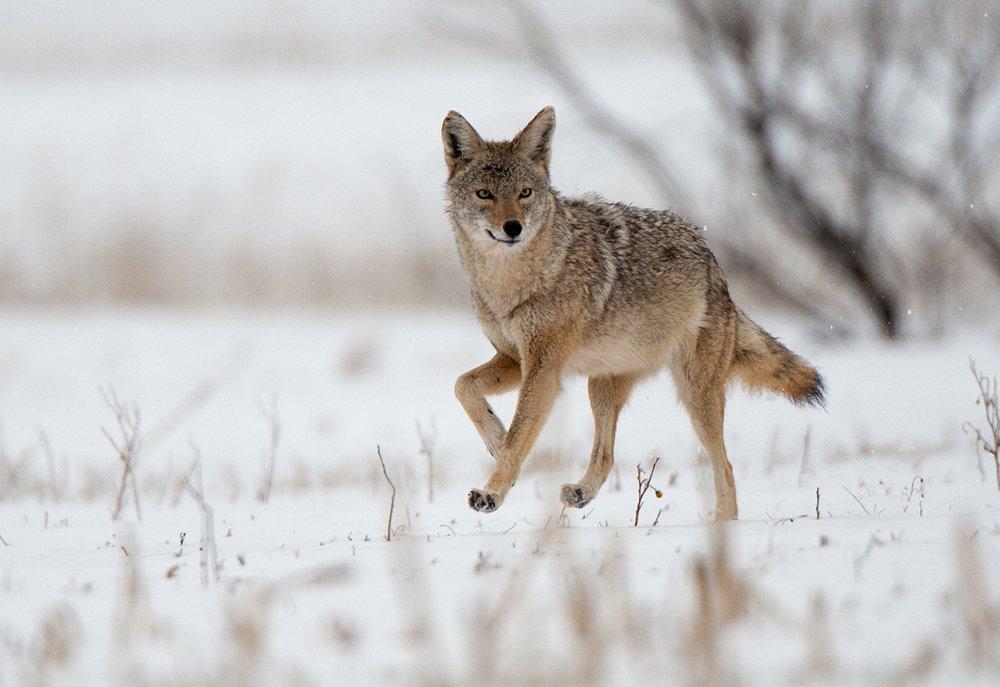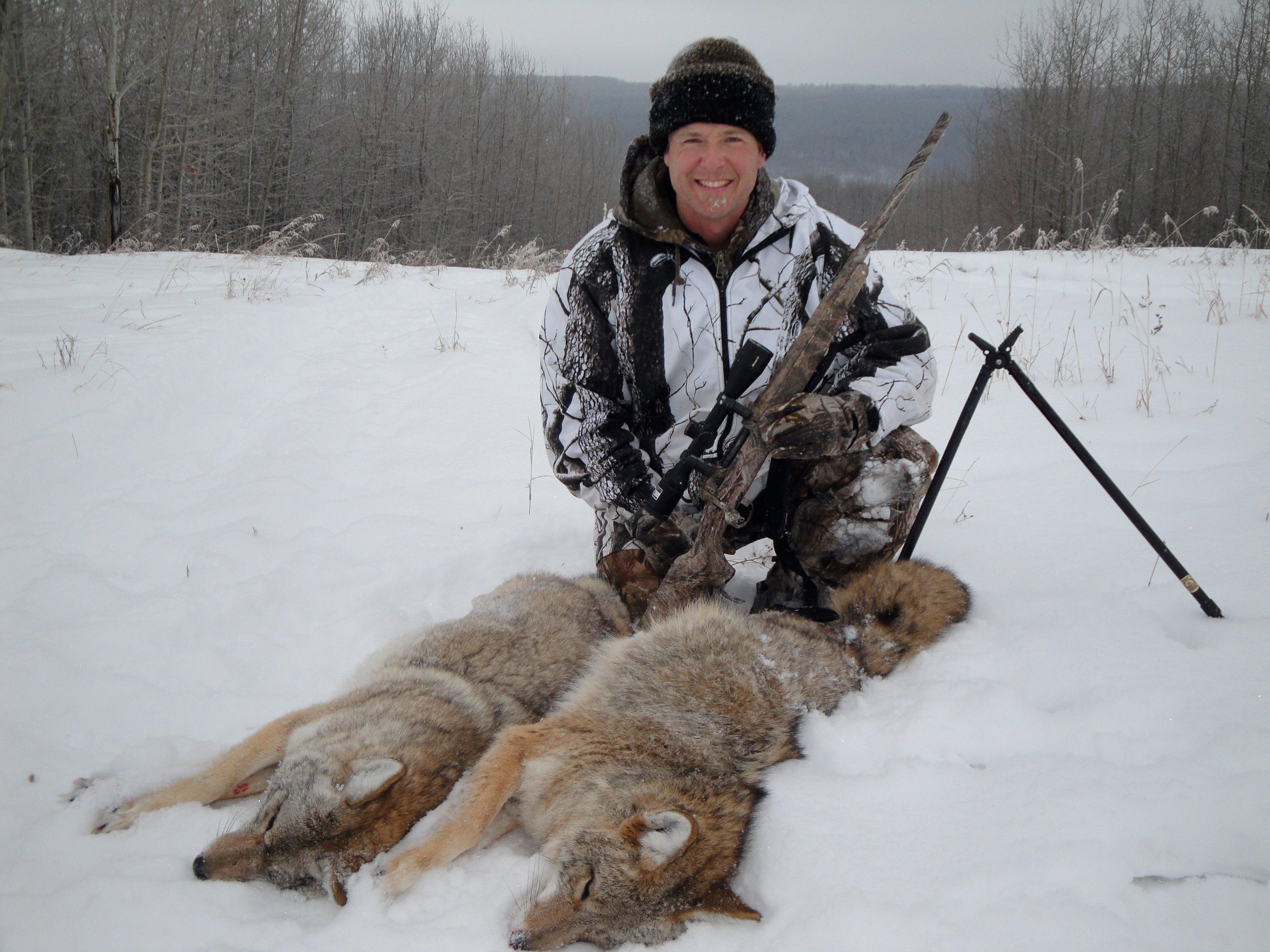Realtree Pro Staffer Fred Eichler Offers Some Predator Hunting Tips
You know how hungry you get when you're out hunting or working in the freezing cold during a long winter day? How the cold seems to sap your energy and strength, making you think about eating a snack or checking your watch to see if it's time yet for lunch? How your body quickly burns through the fuel you fed it for breakfast and demands more?
Well, that's exactly the reason you should be out hunting coyotes on cold, snowy days. They are out in that cold day and night and they're always on the prowl for something to eat, making them susceptible to calling.
The main reason I like hunting coyotes in the winter is their calorie intake is higher, said Realtree pro staffer Fred Eichler. Just like any animal, coyotes need more calories to survive the cold and that makes them more responsive to come to a call, particularly to an animal-distress call that makes them think they can pick up an easy meal.
Plus, snow provides other benefits to coyote hunters, helping you pattern coyote movement, their tracks and scat easily visible in fresh snow telling you their travel routes, their hunting places, the places they use for cover.
Scouting for Coyotes
When scouting to figure out where to set up to call, snow helps reveal important information. You can see their travel routes and not have to guess. And you don't have to hunt so hard for scat or tracks or urine posts. You can see exactly what the coyotes are doing, said Eichler, who hosts Predator Nation TV show on Sportsman Channel.
The best thing about hunting them in snow is figuring out their travel patterns, where they are traveling to and from, where they are laying up, where they are hunting, he said. Look along fencelines, brushpiles or ravines. I look for where those tracks are going both ways. Just like when I'm deer hunting, I'd much rather set up at a cross trail or even a triple-cross trail than I would one trail. And with coyotes if I can get where multiple coyotes are going down a fenceline or coming into an area, that's where I'm going to set up.
Look for tracks and sign of prey species too, he said. Where you find prey, you'll find predators.
Hunting in Snow
With snow on the ground, there are fewer areas for prey to hide, Eichler said. They'll be in the thicker stuff where they can hide from coyotes, so I look for brushpiles and shelterbelts and areas like that.
You've got a canvas out there and it is getting written on every day, he said. That's the great thing about winter hunting.
And, against a white background it is much easier to spot coyotes, either hunting, prowling, going about their business or responding to your call, Eichler said. Their camouflage doesn't work so well for them on a big field of snow or even in the woods. You can spot movement, even through trees, a lot, lot quicker.
And winter coyotes have better pelts, prime fur, thickened to help them survive the cold and usually lightened to a nearly white color to match their snowy surroundings and that, to a fur hunter, can mean better prices.
Prime Pelts
I sell quite a few every year and those are the pelts I'm looking for because they are prime, said Eichler, who hunts and traps on and around his southern Colorado ranch.
Winter coyote hunters need to keep other changes, other considerations in mind.
Dress for Weather
The obvious one is they are going to need to dress for the weather, so they can stay warm, dry and comfortable while sitting on stand for 15 to 20 minutes without moving, without shifting to be more comfortable or moving around in an attempt to get warm, Eichler said.
Warm clothes, or more accurately, layers of warm clothes are a must. Try to dress so you can vent away the heat of walking to a stand so you don't build up perspiration that will help cold seep in once you stop and set up for calling. Warm footwear is a must, but again something comfortable to walk in without overheating. Extremities like toes and fingers are the first to feel the cold, as are ears and nose, all of which can and should be well-protected.
Staying dry is also a must, and even though the weather may be cold and dry if you sit in snow for 20 minutes, you can expect some melting and a wet rear end, no matter the temperature. Or snow on your clothing can melt when you climb back into your pickup for the run to the next stand. Wear clothing that keeps water out.
Seat cushions are always a good idea to keep you comfortable, but an even better idea in winter to protect your rear from the snow and cold, Eichler said. He recommends the Tenzing Predator Pack, with a thick fold-down padded seat - not something that rain or snow is going to soak through - that keeps him out of the snow, plus spring-loaded legs that extend to provide a built-in backrest. I'll tell you as I get older that backrest is pretty nice, he said, laughing.
There are other gear considerations, too, for hunting in winter, he said.
Calling Tips
The cold can sap batteries of their power faster and wreak havoc on calls.
I carry extra batteries for my e-caller, he said. And I also carry extra diaphragm and mouth calls. Diaphragm or reed calls can freeze, so I carry multiple calls so if one freezes up I can rotate to another without messing up my sequence.
Snow can also change the landscape and how coyotes - and hunters - relate to it, Eichler said.
Sometimes it is just a matter of where I can get to easily, he said. It doesn't affect me too much unless there is too much snow in a ravine and I have to figure out a better way to get there.
But it can change how coyotes will approach a call.
How Coyotes Move
Coyotes, he said, are going to search for the easiest way to travel, so he keeps that in mind when setting up to call. Travel routes may have changed. Where coyotes may have traveled in low-lying areas, deep snow might force them to travel along a ridge swept clear of snow by the wind.
Eichler said he hunts frequently at high elevations, ranging from 7,000 to 11,000 feet where snow conditions can change from day to day. I live at 7,000 feet, he said, where one day snow may be powder and a coyote can't get across it but then it gets some sun and glazes over and a coyote that wouldn't cut through there the day before now can run right across the top.
If that sounds like he's speaking from experience, he is.
Changing Conditions
He continued, Watching changing snow conditions is important because you can get caught off guard and I know because I have been caught off guard, where I went, oh, man there's 2 feet of snow down in that big draw and they wouldn't cross it yesterday so today I'm going to set up and ignore that because I know nothing is going to come through there and then a coyote pops up over my left shoulder and I say, what the heck, and I follow it back and see I missed the fact the sun melted the top of the snow, then it froze hard and he came over the top of it just like it was pavement.
So, just like most hunters, a lot of stuff I learned just by making mistakes.
When it snows, Eichler pulls out his Realtree AP Snow Camo because just like I can spot coyotes easier in snow, they can spot me easier in snow too. In winter with white snow all around them, coyotes are used to seeing white, he said, so Snow Camo lets him blend in and disappear into his surroundings.
But for all the changes snowy winter conditions bring for coyote hunters, the fundamentals remain the same, he said. I still try to have the sun at my back whenever possible so it is in the coyotes' eyes as they come in, he said. And I'm still watching the wind, watching for changing currents. The basics of hunting stays pretty much the same, but it's cold and snowy. And I love it.
Go here for more Realtree Predator Hunting. Follow us on Facebook.
Editor's note: This Realtree.com article was first published Feb. 3, 2017.








